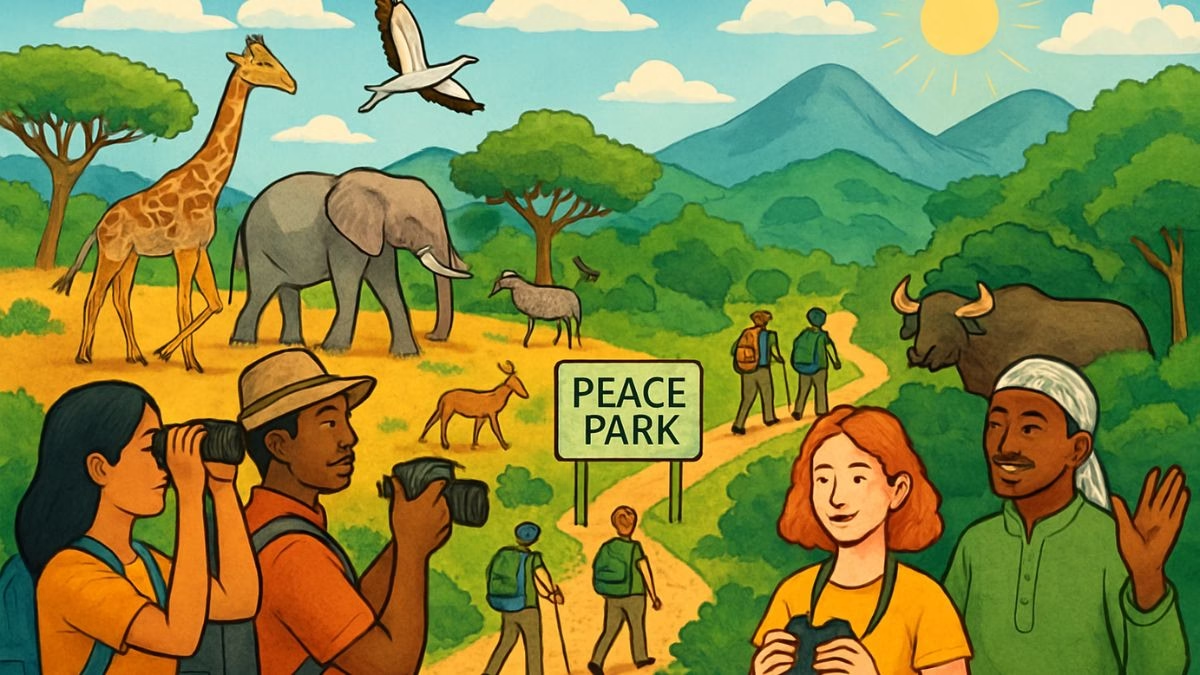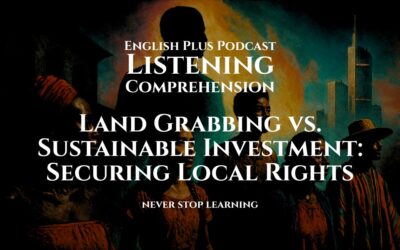Brief Listening-Skills Introduction (Tips)
For lectures like this, listen for the organizational spine: definition → mechanisms → cases → risks → takeaways. Mark signposts (“first,” “by contrast,” “in practice”), and track cause–effect language (“which in turn,” “therefore”). When numbers or labels appear (e.g., carrying capacity, stakeholders, monitoring), star them—exams love testing specific terms and conditions. After listening, compress the main idea into one sentence, then list three mechanisms with short examples to prep for inference questions.
Micro-Introduction to the Topic (Anticipation)
You’ll hear a lecture arguing that Peace Parks—transboundary wildlife corridors jointly governed—turn ecological interdependence into political cooperation. Expect discussion of co-management, biodiversity, tourism value chains, and conflict-sensitive livelihoods, plus cautions about poaching, over-tourism, and unequal benefits.
Keywords & Phrases (Used in the Script)
Peace park — a conservation area spanning borders to enable cooperation.
Transboundary corridor — wildlife pathway across national frontiers.
Co-management — shared governance by multiple authorities/communities.
Biodiversity — variety of species and ecosystems; core conservation goal.
Ecotourism — low-impact tourism that funds protection and local income.
Livelihoods — ways people earn a living; linked to conservation incentives.
Stakeholders — groups with a stake in outcomes (rangers, communities, tour operators, agencies).
Carrying capacity — maximum use without degrading the ecosystem.
Anti-poaching — measures to deter and respond to illegal hunting/trade.
Rangers — frontline conservation personnel; often joint patrols.
Revenue-sharing — distributing tourism income to local communities.
Human-wildlife conflict — clashes over crop loss, predation, or safety.
Habitat connectivity — linked habitats that allow species movement.
Stewardship — responsible, long-term care for shared resources.
Data interoperability — systems that allow cross-border data to integrate.
Listening Audio
Listening Transcript: Please do not read the transcript before you listen and answer the questions.
A peace park is a conservation area that crosses national borders to protect biodiversity and to convert shared ecological interests into shared political routines. The premise is simple and profound: wildlife does not read passports, and rivers do not stop at customs. Where jurisdiction fragments a continuous landscape, transboundary corridors stitch it back together. The stitching is not only ecological; it is diplomatic. When two or more countries agree to co-management, they create a place where cooperation is practiced every day—by rangers on patrol, by scientists comparing notes, and by communities building livelihoods tied to protection rather than extraction.
Let me start with the ecology, because ecology supplies the why. Large mammals, migratory birds, and pollinators depend on habitat connectivity. If a migration route is severed by fences, farms, or fear, populations decline even when one side of the border is well protected. Peace parks re-link the route so movement—seasonal, genetic, and behavioral—can resume. Biodiversity is not a museum exhibit; it is a living network. Corridors expand the effective size of habitat, reduce inbreeding, and spread risk: drought in one valley is less catastrophic when herds can shift to another. This ecological logic is the quiet engine of diplomacy: when both sides gain healthier ecosystems, both sides have reason to maintain the arrangement.
Now to the governance, which supplies the how. Co-management means authorities share responsibilities for zoning, enforcement, monitoring, and visitor experience. It can take many shapes: a joint commission with equal votes; a secretariat that coordinates ranger deployments; memoranda that align penalties for the same offense across borders. At the working level, co-management looks like calendars and radios: synchronized patrols so poachers cannot sprint over a line to evade capture, and data interoperability so camera-trap images and GPS tracks can be shared without heroic effort. The practical message is: a boundary on a map is not a barrier to stewardship.
Any peace park that endures must integrate livelihoods. People who live nearest to wildlife often bear the highest costs—crop loss from elephants, predation of goats by big cats, or time spent navigating new rules. If benefits flow elsewhere, resentment grows. Ecotourism can be the hinge that aligns incentives, but only when revenue-sharing is concrete and timely. A lodge that pays a community dividend per bed-night; a guiding co-op that trains local youth; a craft market sited on the park’s edge so visitor spending sticks—these are not gestures; they are mechanisms. When a portion of every tourist’s fee funds school repairs or a clinic, the peace park becomes legible as a livelihood strategy, not just a conservation idea.
Consider rangers: they are the translators between policy and reality. In peace parks, rangers often patrol in mixed teams. This is not only about coverage; it is about trust. When a mixed patrol arrests a poaching crew, the subsequent process—evidence logged, suspects handed over, reports mirrored on both sides—becomes a rehearsal of fairness. The protocol matters because rumors travel faster than trucks. If people believe enforcement is lopsided, cooperation frays. Joint drills, shared radio codes, and standardized incident reports build credibility. Even small details matter, like agreeing on how many days seized snares must be stored before destruction and who witnesses the destruction. Accountability is a choreography, and rangers learn the steps together.
Human-wildlife conflict is the stress test for any peace park. In theory, corridors allow wildlife to move without trespassing fields; in practice, elephants do not prefer fences, and predators do not read zoning bylaws. Co-management addresses this with layered strategies: early-warning systems that send SMS alerts when collared elephants approach; community rapid-response teams trained to use chili bricks, beehive fences, or noise to deter crop-raiding; compensation schemes that are fast, fair, and accompanied by assistance to prevent repeat incidents. Notice the pattern: respect the people’s time, acknowledge loss, and solve for the next night, not just the last one. When conflict is reduced, tolerance increases, and the corridor’s legitimacy grows.
Tourism is a double-edged tool; it can finance stewardship or overwhelm it. Carrying capacity is the guardrail. Instead of chasing headcounts, co-management can set caps—vehicles per viewing zone, hikers per trail per day, or aircraft per hour over a nesting site. A reservation system that spans borders prevents a perverse incentive for one side to accept overflow that the other side prudently turned away. The goal is not austerity; it is quality. Visitors who see fewer vehicles at a sighting are more likely to stay longer and to recommend the park to friends, which in turn supports higher guide wages and steadier community dividends. A well-managed encounter is a renewable asset.
The politics of peace parks are subtle. They do not dissolve disputes about territory or history, but they offer a stage where rivals can collaborate without first agreeing on everything. Joint fire management, invasive-species control, or river-basin monitoring creates a rhythm of meetings and field days where language softens: “our burn window,” “our buffalo count,” “our nesting success.” That pronoun shift—from “mine” and “yours” to “ours”—arrives not by decree but by repetition. Diplomacy becomes local and durable when it is embedded in calendars and checklists.
Let me sketch a composite example. Two neighboring countries, long wary of each other, share a mountain range where snowmelt feeds both of their major rivers. Along the crest runs a mosaic of alpine meadows and forests that shelter an endangered ungulate and a culturally revered eagle. Poachers have learned to exploit the border: they set snares on one side and drag carcasses over the line to confuse evidence. Meanwhile, unregulated tour groups crowd a popular pass in summer, while villages below struggle with crop-raiding in late autumn. The countries establish a peace park with a transboundary corridor along the ridgeline and a joint commission for governance. They harmonize fines, adopt a shared anti-poaching strategy, and train mixed ranger patrols with mountain-rescue skills so they can handle tourism incidents as well as wildlife crimes. They create a binational booking platform that allocates permits across both sides and limits the daily number of vehicles at the pass. Revenue-sharing directs a percentage of permit fees to a community fund, which—crucially—is co-managed by elected representatives from both sides and audited publicly.
Within a year, the first indicators move. Mixed patrols cut poacher success rates because escape routes lose their advantage. A community-run guiding co-op trains eight young people, four from each side, whose bilingual tours become a feature rather than a novelty. Human-wildlife conflict teams install beehive fences around the most vulnerable fields, reducing elephant damage; the honey is bottled under a joint brand and sold to visitors at the pass. The eagle nests, once disturbed by drones, are now off-limits during breeding season thanks to signage, clear maps in the reservation app, and fines enforced by both countries. The river runs a bit clearer because erosion from off-trail driving declines. None of these changes are dramatic enough for a headline by themselves; together they form a new normal of stewardship.
Data interoperability keeps this machine honest. Camera traps do not care who buys them, but databases do. When the peace park adopts a shared platform—species IDs standardized, metadata fields aligned, GPS in the same datum—scientists can detect trends across the entire corridor rather than in isolated segments. That makes management more intelligent: if migration is shifting earlier due to climate signals, both sides adjust road-closure calendars in tandem. Decisions feel less political because they are anchored in a common record.
Is a peace park a panacea? No. It can mask inequities if benefits remain elite. It can spark resentment if conservation law is enforced against the poor while traffickers up the chain escape. It can even become a new arena for competition if countries treat visitor numbers as bragging rights. The antidote is design integrity: transparent revenue-sharing, grievance mechanisms that actually resolve complaints, clear penalties for corruption, and periodic independent audits. Equally important is humility: admit when carrying capacity was misjudged; change the quota; explain why.
One often overlooked dimension is culture. A corridor with sacred sites requires more than ecological zoning; it needs cultural zoning. Co-management can designate quiet hours near shrines, provide training for guides in local etiquette, and fund the restoration of traditional footpaths so that visitors encounter living culture rather than a staged performance. When people see their heritage respected, they are more likely to see themselves as stakeholders rather than obstacles. Stakeholders who feel seen become stewards.
What about security? Skeptics worry that transboundary areas could be exploited by smugglers or armed groups. This risk is real, which is why joint operations protocols matter. Mixed patrols coordinate with border agencies; radio repeaters are placed where both sides can reach them; and rules of engagement are harmonized to prevent confusion. The presence of trained, respected rangers can stabilize remote zones because they are known, predictable faces—first responders to fires, searchers for lost hikers, mediators when livestock stray. Conservation becomes a service, not a surveillance.
The most moving evidence that a peace park is working often arrives in unceremonious moments: a cross-border school exchange where kids compare plaster casts of footprints; a market day where handicrafts from both sides share a stall; a ranger’s retirement ceremony with handshakes in two languages. These are not add-ons. They are the human texture that sustains co-management through bad seasons, when drought shrinks rivers or when one unlucky predator kills livestock despite every precaution. In those moments, relationships—patiently built in patrols, meetings, and workdays—carry the weight.
To conclude, a peace park is less a place than a practice. It is the practice of turning ecological facts—animals move, water flows—into political habits—meet, plan, adapt. Transboundary corridors expand habitat; co-management turns neighbors into colleagues; ecotourism and revenue-sharing link pride to protection; anti-poaching and conflict mitigation defend both wildlife and dignity; carrying capacity disciplines ambition so beauty can persist. If diplomacy is often imagined as distant rooms and delicate phrasing, peace parks remind us that shared landscapes can be the most persuasive diplomats of all. On a good day, a herd crosses a ridge as it has for centuries, a child watches through borrowed binoculars, a ranger notes the time and the direction, and two countries quietly agree—again—to keep the path open.










0 Comments